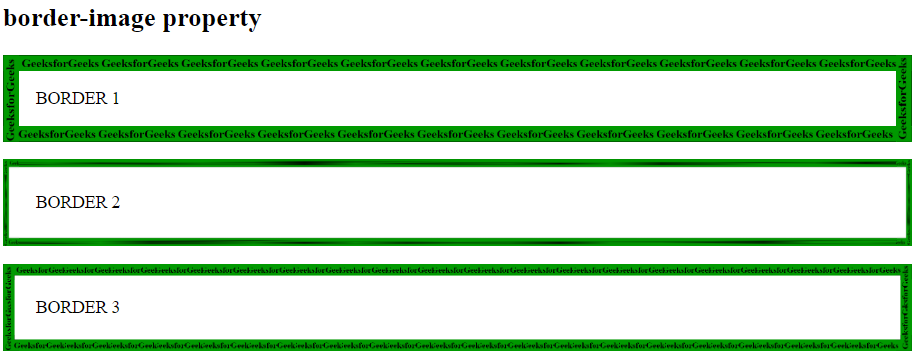语法如下:
border-image: source slice width outset repeat|initial|inherit;border-image属性是下面列出的许多属性的组合:
- border-image-source
- border-image-slice
- border-image-width
- border-image-outset
- border-image-repeat
属性值:
border-image-source:此属性用于设置边框图像的源位置。
语法如下:
border-image-source: url(image source location);border-image-slice:border-image-slice属性用于划分或分割border-image-source属性指定的图像。
border-slice属性将给定图像划分为:
- 9个地区
- 4个角
- 4条边
- 中部地区
语法如下:
border-image-slice: value;border-image-width:
border-image-width属性用于设置边框的宽度。
语法如下:
border-image-width: value;border-image-outset:
border-image-outset属性设置元素边框图像从其边框框中显示的距离。
语法如下:
border-image-outset: value;border-image-repeat:
border-image-repeat属性定义了如何调整源图像的边缘区域以适合元素边框图像的尺寸。
语法如下:
border-image-repeat: value;初始:
它用于将border-image属性设置为其默认值。
继承:
它用于从其父级设置border-image属性。
范例1:
<!DOCTYPE html>
< html >
< head >
< title >
CSS border-image Property
</ title >
< style >
#borderimg1 {
border: 10px solid transparent;
padding: 15px;
-webkit-border-image: url(
'https://media.lsbin.org/wp-content/uploads/border2-2.png')
30 round;
border-image: url(
'https://media.lsbin.org/wp-content/uploads/border2-2.png')
30 round;
text-align:center;
}
#borderimg2 {
border: 10px solid transparent;
padding: 15px;
-webkit-border-image: url(
'https://media.lsbin.org/wp-content/uploads/border2-2.png')
30 stretch;
border-image: url(
'https://media.lsbin.org/wp-content/uploads/border2-2.png')
30 stretch;
text-align:center;
}
</ style >
</ head >
< body >
< h2 >border-image property</ h2 >
< p id = "borderimg1" >
Element Content
</ p >
< p id = "borderimg2" >
Element Content
</ p >
</ body >
</ html >输出如下:

范例2:
<!DOCTYPE html>
< html >
< head >
< title >
CSS border-image Property
</ title >
< style >
#borderimg1 {
border: 15px solid transparent;
padding: 15px;
border-image:url(
'https://media.lsbin.org/wp-content/uploads/border2-2.png')
50 round;
}
#borderimg2 {
border: 15px solid transparent;
padding: 15px;
border-image:url(
'https://media.lsbin.org/wp-content/uploads/border2-2.png')
40% stretch;
}
#borderimg3 {
border: 15px solid transparent;
padding: 15px;
border-image:url(
'https://media.lsbin.org/wp-content/uploads/border2-2.png')
70 round;
}
</ style >
</ head >
< body >
< h2 >border-image property</ h2 >
< p id = "borderimg1" >BORDER 1</ p >
< p id = "borderimg2" >BORDER 2</ p >
< p id = "borderimg3" >BORDER 3</ p >
</ body >
</ html >输出如下:

支持的浏览器:支持的浏览器边框图像属性下面列出:
- Google Chrome 16.0、4.0 -webkit-
- Internet Explorer 11.0
- Firefox 15.0、3.5 -moz-
- Opera 15.0、11.0 -o-
- Safari 6.0、3.1 -webkit-

